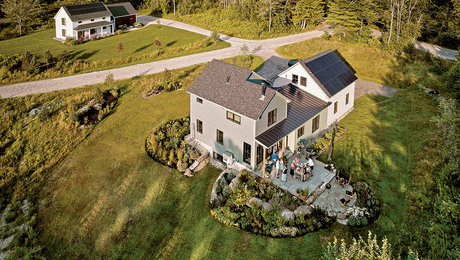Reading another thread on grounding made we wonder –
How much sense doies it make to drive a ground rod within the backfilled overdig area, especially where there is a basement?
Especially if much of the overdig is backfilled with gravel?
“We should be so good at whatever we do that no one can afford us, if they had to pay what we’re worth.” Flock’s Diner Blog, 11-28-06 http://peoplesheep.blogspot.com/



















Replies
Code wise it does not make any difference in the NEC. The building codes might say something about what can be put in backfill areas.
Functionally you can always test it it you want to spend the $$$ money for a meter.
As to how bad it is then that depends on what two things the backfill conditions and what other electrodes are used.
I would not be too concerned that this is a in disturbed ground. It will settle soon enough to give good contact. However if there is enough gravel then might not be earth in the matrix that you have electrical contract through out the mix.
The other is what other ground electrodes are used?
Since this is apparently new construction then there should have been a UFER ground if they though ahead. If so then a ground rod is not even needed.
Also if there the water service is used as a Ground Electrode and NOT JUST BONDED then the ground rod is only needed for a backup if they replace the water service line with plastic sometime in the future. By that time the ground rod would be well settled in place unless it was in 80% gravel.
If all you have is two ground rods and both of them are in heavy gravel then it needs to be redone.
I'm just thinking about what I usually see.They don't r4equire UFERs in my area, sticking with 1 to the water supply and (recently) one to a ground rods.In theory, the best backfill for structural purposes (esp in regions with high clay content) is gravel. I started thinking:"how long does it take for fines to fill in between the gravel" to establish good contact."
"We should be so good at whatever we do that no one can afford us, if they had to pay what we're worth."
Flock's Diner Blog, 11-28-06
http://peoplesheep.blogspot.com/
I wonder how effective a Ufer is in a slab when a poly vapor barrier is required?Any thoughts?
My guess is about zero.I am assuming that you are talking about a monolithg slab footing pour.Otherwise it does not matter how the slab is done. And if wanted you can put a moisture barrier on top of the footing.
I dont know how well 6 mils of polyethylene (with the usual nicks and holes made during pouring) is as an insulator. When I did mine I left the poly off the bottom of the footing and outside of the monolithic slab. Had to have 2 ground rods at the meter anyway, so I guess I am fairly well grounded.
P.S. this is the Oregon coast so its pretty moist.
P.P.S wonder why nobody addresses this....should I post a querry to the next NEC to do?
Reading the actual working looks like it is covered."..an electrode encased in at least 2" of concrete, located within and near the bottom of a conceerete foundation or footing IN DIRECTION CONTACT WITH THE EARTH.."."ad to have 2 ground rods at the meter anyway"Why?
Why 2 ground rods connected to the meter base? ..well the power company wanted it that way. In Wa. state they just wanted the panel grounded with #6 whereas a ufer calls for # 4 .
I found out that this area was apparently not clear, but the 2005 NEC says that whenever you use a ground rod that you either need to use two ground rods or measure it at least than 25 ohms..
.
Hey every group has to have one. And I have been elected to be the one. I should make that my tagline.
Here is a chart that list the resistance of ground rods in different types of soils and gravels.http://home.earthlink.net/~jimlux/hv/grounds.htm.
.
Hey every group has to have one. And I have been elected to be the one. I should make that my tagline.
1015 ohms/centimeter. For a milimeter thickness that would be 100,000,000,000,000 ohms.
(with the usual nicks and holes made during pouring)
Total the square inches of all those openings that are directly under the footing and that's all the grounding area you have. A 6'x1/2" rod has 113"2 surface.SamT
Now if I could just remember that I am a businessman with a hammer and not a craftsman with a business.....segundo <!----><!---->
If you can get in there before the backfill you can bury a ground wire loop.